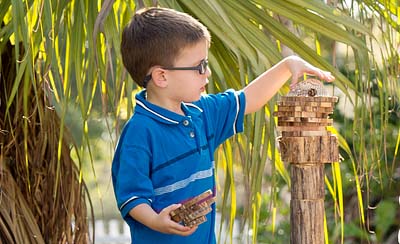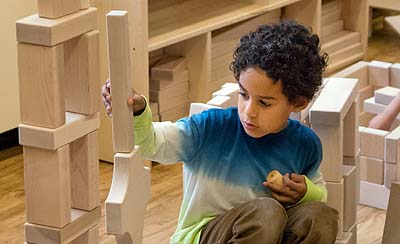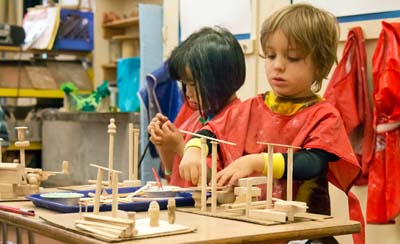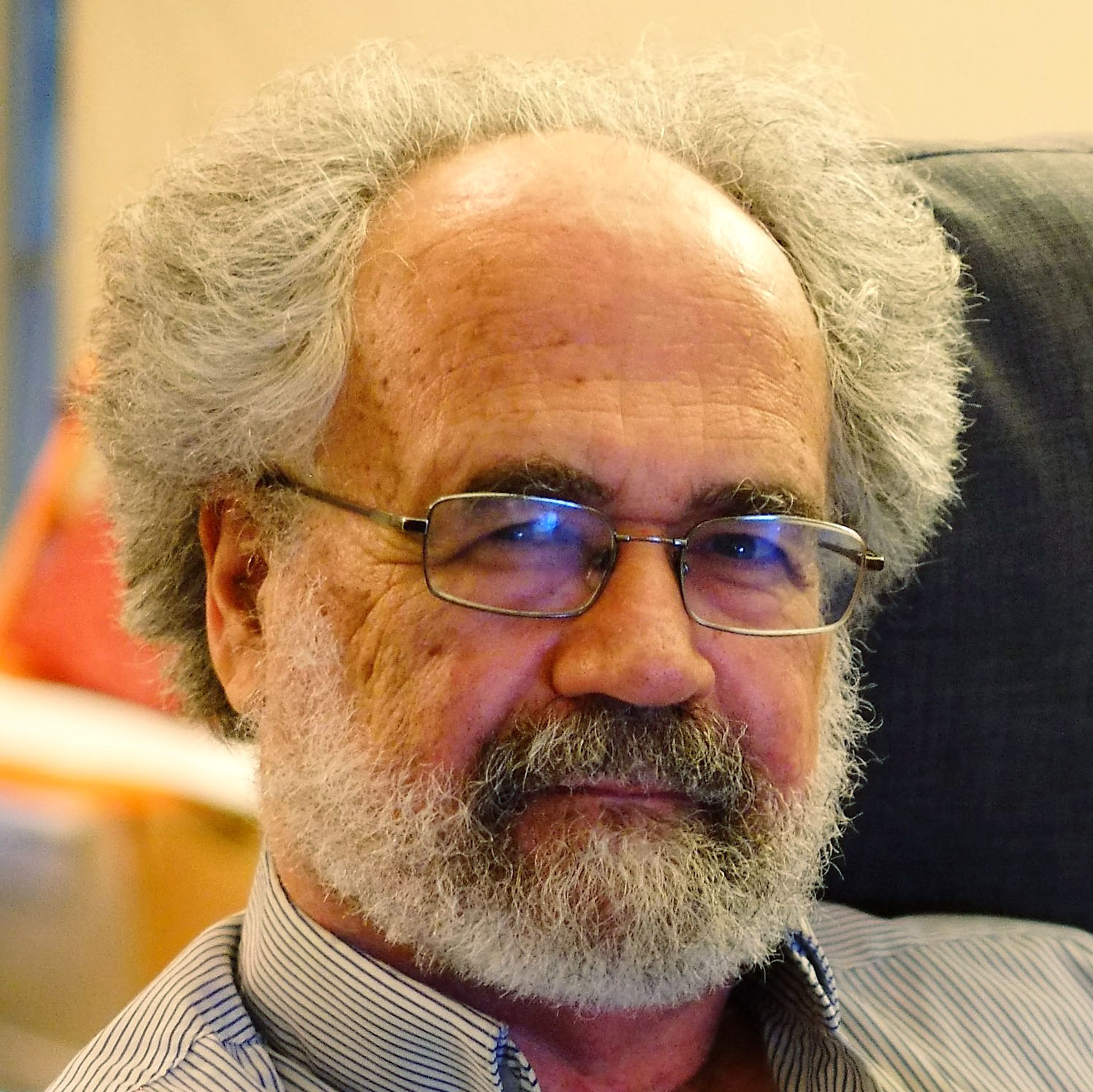The Importance of Constructive Play
August 11th, 2015
by Katrina Brooke
Author: Francis Wardle
One of my favorite activities as a young child growing up on a farm in the beautiful border country between England and Wales was to go outside after the frequent heavy rains we often experienced (or even while it was raining) to dig and build little ditches, channels, aqueducts, tunnels, diversions, and dams for all the runoff. I also loved creating fantastic marble shoots with my peers at school using several sets of unit blocks. I remember some of these block creations were so high that they touched the classroom ceiling! Both these activities involved constructive play. In this article I argue that, while constructive play is often viewed as secondary to both physical and symbolic/fantasy play, it is critically important for young children, and should be encouraged and supported both in the classroom and on the playground.
Piaget’s Stages of Play
According to Piaget, children engage in types of play that reflect their level of cognitive development: functional play, constructive play, symbolic/fantasy play, and games with rules (Johnson, Christie & Wardle 2005).
- Functional play is the use of bodily movements, with or without objects, such as running and jumping, sliding, gathering and dumping, manipulating and stacking objects, and informal games without rules.
- Constructive play uses objects—blocks, Legos, Tinkertoys, or different materials (sand, modeling clay, paint, blocks)—in an organized, goal-oriented way to make something.
- Symbolic/Fantasy play is role playing or make-believe play, such as pretending to be a baby, firefighter, superhero, or monster, and make believe actions, such as driving a car by moving a pretend steering wheel, or using a block of wood as a cell phone.
- Games with rules are games with peers that are controlled by pre-established rules, such as tag, Mother-May-I, checkers, Duck-Duck-Goose, and so on.
Piaget also viewed these forms of play as progressive, or cumulative, beginning with functional play (i.e. an infant playing with a rattle) and progressing to games with rules. But, because a game with rules requires someone to make sure players adhere to these rules—usually an adult—it is often not included within the framework of free play. And, while functional play is the kind of play encouraged in most outdoor playgrounds (swinging, sliding, riding tricycles, running, and climbing), symbolic/fantasy play is viewed by many experts as the highest level of play in the preschool and kindergarten years (Leong & Bodrova 2015). Early childhood scholars believe that symbolic/fantasy play develops children’s social skills, basic mathematical abilities, early literacy concepts, and behavioral self-regulation. Unfortunately some have even called it mature play (Leong & Bodrova, 2015). Thus constructive play is often left out of the discussion regarding the critical importance of play, or is simply viewed as a bridge between functional play and the supposedly more desirable and sophisticated symbolic/fantasy play.
Constructive Play is what Young Children Do
With the current focus on early childhood standards, assessment of young children’s progress, and early childhood academic activities, early childhood educators continually have to justify the use of play in the curriculum. Often this justification is that play prepares children for later academic, social, and emotional successes (Leong & Bodrova 2015). But, while constructive play teaches children to be flexible thinkers (Bruner 1972), and develops a sense of control and self-esteem by encouraging children to control their environment (Chaille 2008), I believe the main value of constructive play is that it enables children to be children: to do what children need to do and want to do!
In fact, research shows that when given a choice of free play activities, constructive play is chosen more than 50% of the time by preschool children (Rubin, Fein, & Vandenberg 1983), and for preschool children, constructive play was also their favorite outdoor activity (Ihn 1998). Further, constructive play is wonderful for children who may not be quite ready to move on to symbolic/fantasy play: many boys, children with delayed or slow language development, those whose social development may be immature, and children with certain disabilities.

Constructive play allows children to manipulate and control their environment
Constructivist Learning
I often enjoy playing with my 4-year-old grandson, Isaac. When he visits us at our home, he loves to play with the set of unit blocks that we acquired for our own children. He loves to make patterns on the floor, matching up different size blocks, and placing blocks of the same shape and size together. But recently everything changed: he decided his goal now was to place all the blocks on end, and to see how high he could build them! He even tried constructing these structures on a gymnastics mat (which happened to be on the floor) until he discovered that this did not provide the needed stability.
Isaac’s goal had changed because his view of the world had changed as a result of his cognitive development. Our understanding of constructive play comes from the constructivist view of development and learning (Chaille 2008). This approach to early childhood education is about responding to children who are, by nature, exploring, discovering, and theory building in everything they do. It is a theory that believes children construct knowledge through interactions between their own ideas and experiences in the social and physical world. Thus, learning from a constructivist perspective is intrinsic, because children continually try to make sense of their world, which is what Isaac was doing.

Encouraging Constructive Play
The most important thing in encouraging constructive play for young children is to understand the value of this kind of play, in and of itself, and not to view it as preparation for future academic success and development, or as a bridge to symbolic/fantasy play. Children should be encouraged and supported to fully enjoy, explore, and appreciate constructive play. Further, enough time every day needs to be provided for all kinds of play, and constructive play should be encouraged inside, in transition areas (i.e. porches or decks), and on the playground. This begins by providing a vast array of stimulating materials such as:
- Unit and hollow blocks
- A woodworking area
- A variety of puzzles
- Mosaic tiles and patterns
- Milk crates, boxes, and other cubes
- Clean pieces of wood of different sizes, shapes, and strengths
- Sticks and stones, leaves, bark, and other natural materials
- Sand and sand toys
- Water and water toys
- Clay, play dough, and other modeling materials
- Paints, brushes and easels, chalk, crayons, stencils, drawing tools, and other art materials
- Car tires (bias and clean)
- Wagons and tools to move sand, dirt, and other materials (Wardle 2000).
Indoors
Because constructive play is driven by children’s interactions with their environment (Chaille 2008), changing the environment encourages all sorts of constructive play. Adding new and novel materials to indoor learning centers is one way to increase constructive play indoors; another is to integrate materials across learning centers: the woodwork bench with the art area, the science and block area, the literacy area with the math manipulatives, and so on. Finally, taking materials outside and bringing materials into the classroom from the playground, are additional ways to increase constructive play.

Outdoors
Well-designed water play areas and sandboxes encourage constructive play because so much can be done using these very flexible materials (Ihn 1998). A hardtop area within the playground or transition area between the classroom and playground encourages play with unit and hollow blocks, water tables, woodwork benches, art easels and paints, and other traditional classroom materials. A large garden also encourages a variety of constructive play.
However, children also need to be encouraged to use traditional classroom materials and equipment in novel and innovative ways outside, such as painting on the sidewalk or fence, making garden signs and building birdhouses on the workbench, and building higher and bigger with blocks. In general, outdoor play is louder, takes up more space, uses more—and often different—materials, and is messier than indoor play(Johnson, Christie & Wardle 2005).
Conclusion
Constructive play is what young children do naturally. While other forms of play can be justified as preparing children for later academic and life successes, constructive play should be encouraged and supported because it lets children simply be children. This, many believe, is the best possible preparation for later achievements. Providing adequate time each day for play, and continually changing, combining, and adding new and more complex materials, both indoors and on the playground, are the best ways to support constructive play.
References
Article
Date: August 11, 2015
Author: Francis Wardle


Francis Wardlehas a PhD in child development and early education from the University of Kansas, and has been a Head Start volunteer, education coordinator, director, and national reviewer. He has taught preschool, kindergarten, and grades 1-4. His own constructive outlet is designing and building playgrounds in this country and Brazil. Currently he teaches for the University of Phoenix (School of Advanced Studies) and Red Rocks Community College.
Comments Closed
|